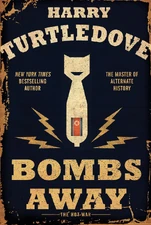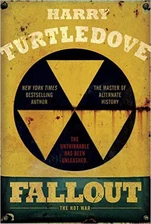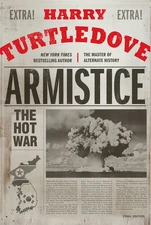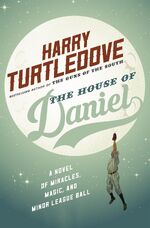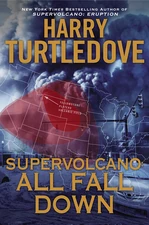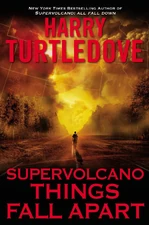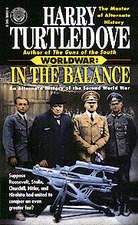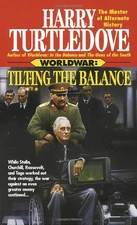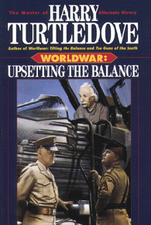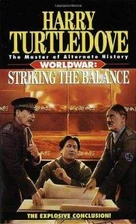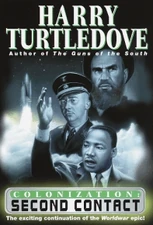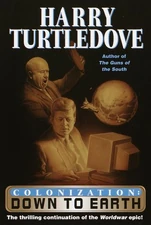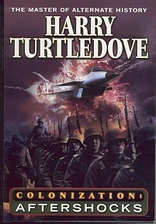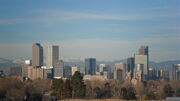
Denver is the state capital and largest city in the U.S. state of Colorado. It is located at the base of the Rocky Mountains. It has been nick-named "The Mile High City", due to its elevation of roughly 5,280 feet. It has also been called the "Queen City of the Plains" as it has been one of the largest metropolitan areas in mid- and south-west of the country.
Denver in The Case of the Toxic Spell Dump[]
Denver was the capital of Ruddy, one of the Confederated Provinces of America.[1]
Denver in The Hot War[]
Denver was one of several cities atom bombed by the Soviet Union on March 2, 1951. After deploying their bomb, the crew, their plane flying on fumes, landed their Tu-4 at the Air Force base in nearby Colorado Springs and surrendered. Governor Daniel Thornton was among the many casualties.[2]
In the aftermath, the federal government established a number of refugee camps around what was left of Denver.[3]
Denver in The House of Daniel[]
Denver was a cattle town in 1934, but was among the largest towns in the western part of the U.S.[4] It was the home of a tournament for semipro baseball, sponsored by the Denver Post.[5] In June 1934, over a dozen teams converged on Denver to play in the tourney.[6]
However, the very day of the final game, which saw the House of Daniel defeat the Pittsburgh Crawdads, Denver was also the site of the Great Zombie Riots of 1934, during which, the city's zombies abruptly refused to be used as slave labor any longer, and began attacking and killing the living.[7]
Denver in Southern Victory[]
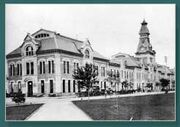
Union Station in 1881, when Abraham Lincoln visited Denver.
Former President Abraham Lincoln visited Denver in 1881 on a speaking tour, just prior to the outbreak of the Second Mexican War. His Socialist ideas found a receptive audience.[8]
During the Second Great War, Denver was a production center for U.S. barrels.[9]. In 1943, it was subject to heavy bombing from a Confederate air raid. This was a diversonary attack to allow a Confederate attack on the U.S. superbomb works in Hanford.[10] In 1944, Confederate President Jake Featherston idly threatened to destroy Denver with a superbomb after his only such weapon had already been expended in Philadelphia.[11]
Denver in Supervolcano[]
Some months prior to the eruption of the Yellowstone Supervolcano, Vanessa Ferguson followed her paramour Hagop Nersessyan to Denver.[12] Hagop had made the decision to move for business reasons, not expecting Vanessa to follow, but continued to have sexual relations with her when she did. Vanessa became frustrated with his emotional detachment and exploded in anger, accusing him of using her as a sexual object. Hagop coolly and unemotionally replied that her moving to Denver was only an "added bonus" and that the sex was the only thing he was interested in. Vanessa angrily broke up with him but remained in Denver.[13]
When the conventional volcano erupted at Ranger Lake, the ash it threw into the atmosphere disrupted flights into and out of the city. This relatively minor effect lulled residents into complacency so that they disregarded warnings when the supervolcano did erupt. However, some forty minutes after eruption a series of earthquakes were felt which did minor damage to buildings and did disrupt power.[14] Denver was not directly destroyed during the eruption although it was close enough to continue to feel earthquakes that resulted,[15] and it was quickly covered in ash and debris.[16]. Some geologists expected up to three feet of ash to accumulate.[17]
People began evacuating in short order,[18] including Vanessa, who fled ahead of most residents on the day after the first eruption and before things grew too bad.[19] Afterwards, no one including the Federal Government, knew how many people died in the Denver metropolitan area but estimates were to the nearest hundred thousand.[20]
Denver in Worldwar[]
When the American team of physicists which had been working on an atomic bomb at the University of Chicago was forced to evacuate Chicago ahead of the Race's invasion, they relocated to Denver,[21] setting up shop at the University of Denver.[22] They were joined there by General Leslie Groves with plutonium captured from the Race.[23]
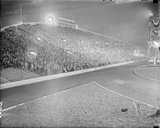
The first American atomic pile was built under the football stadium at the University of Denver.
This plutonium proved helpful to the American physicists and under the leadership of Enrico Fermi, they built an atomic pile and became the first humans to create a sustained, controlled nuclear reaction in Denver.[24] Later, they completed the successful construction of an atomic bomb, code-named "The Fat Lady".[25]
The Race opened an active front in eastern Colorado, launched from Lakin, Kansas in 1943.[26] It was to this body of Race personnel that Jens Larssen attempted to defect.[27] A subsequent drive on the city was successfully defeated by Omar Bradley, when he ordered the detonation of an atomic bomb in the path of the Race's drive, saving the U.S. again from losing the war.[28]
After the United States destroyed Chicago with The Fat Lady, Fleetlord Atvar decided to retaliate by destroying an American city. The Race's computers suggested either Seattle or Denver as targets;[29] eager to disrupt Tosevite oceanic shipping, Atvar chose Seattle[30] (thus killing Vice President Henry Wallace[31]). After the US also destroyed Miami,[32] Atvar was once again presented with Denver and another target as choices for his target. This time the other target was Pearl Harbor, and, against the advice of Kirel, Atvar made the odd choice (from the Race point of view) to destroy Pearl Harbor.[33] Had he chosen Denver on either of these occasions, he would have stopped the production of atomic bombs by the United States, and allowed the Race to overrun and occupy that not-empire.
References[]
- ↑ The Case of the Toxic Spell Dump, p. 259.
- ↑ Bombs Away, pgs. 164-165, ebook.
- ↑ See, e.g., Fallout, loc. 534, e-book.
- ↑ The House of Daniel, loc. 3604, ebook.
- ↑ Ibid., loc. 1548-1592.
- ↑ loc. 3647
- ↑ Ibid., loc. 3920-4157.
- ↑ How Few Remain, pgs. 17-21.
- ↑ The Grapple, pg. 100.
- ↑ Ibid., pg. 177.
- ↑ In at the Death, pg. 277.
- ↑ Eruption, pg. 50.
- ↑ Ibid., pg. 88-90.
- ↑ Ibid., pgs. 166-167.
- ↑ Ibid., pg. 169.
- ↑ Ibid., pgs. 196-203, generally.
- ↑ Ibid., pg. 199.
- ↑ Ibid., pg. 328.
- ↑ Ibid., pg. 196.
- ↑ Ibid., pg. 307.
- ↑ In the Balance, pgs. 382-385.
- ↑ Tilting the Balance, pg. 85.
- ↑ Ibid., pgs. 156-158.
- ↑ Upsetting the Balance, pg. 13-14.
- ↑ Ibid., pg. 401.
- ↑ Ibid., pg. 31, generally.
- ↑ Ibid., see, e.g., pg. 518.
- ↑ Striking the Balance, pgs. 247-250.
- ↑ Upsetting the Balance, pg. 474.
- ↑ Ibid. pg. 475.
- ↑ Ibid., pg. 477.
- ↑ Ibid., pg. 496.
- ↑ Ibid., pg. 497.
| |||||
| ||||||||||||||
| |||||||||||||||||||||
| |||||||
| |||||||||||||
| |||||||||||||||||||||||||
